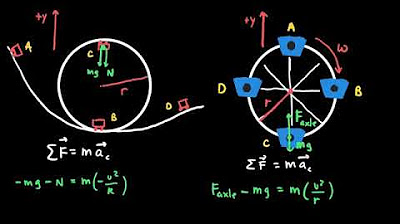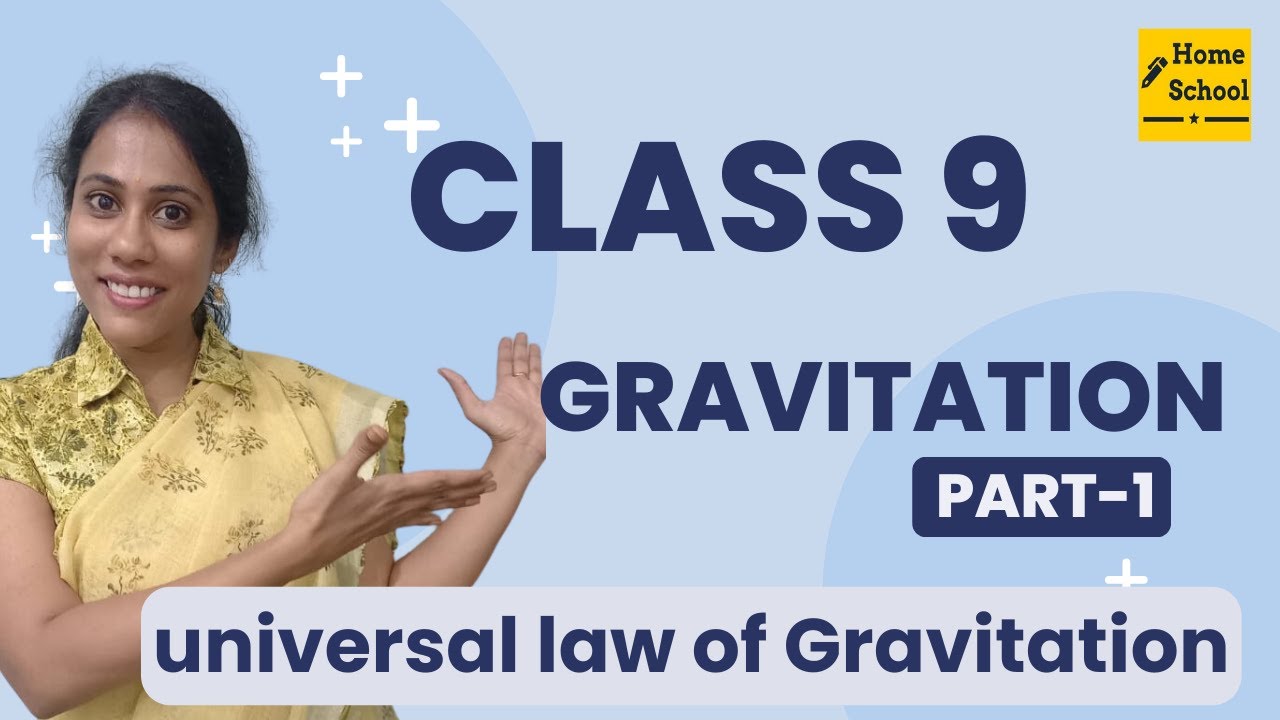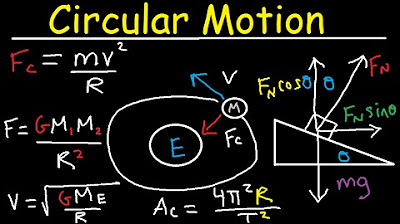College Physics 1: Lecture 22 - Apparent Forces, Orbits, and Gravity
TLDRThis lecture delves into the intriguing world of circular motion, apparent forces, and orbits, with a special focus on gravity. It starts by explaining the sensation of being thrown outward during a sharp turn, which is actually a result of Newton's first law, not a real force. The concept of centrifugal force is introduced as an apparent force experienced during circular motion. The lecture then explores apparent weight variations on a roller coaster, demonstrating how forces act differently at the top and bottom of a loop. It also covers the critical speed concept, where at a certain velocity, the normal force becomes zero, leading to weightlessness. The script further discusses circular motion problems involving forces and motion, leading up to the concept of orbits as a state of continuous free fall around Earth. Finally, Newton's law of gravitation is introduced, illustrating how every object in the universe attracts every other object, with a simple example of the minuscule gravitational force between two people sitting next to each other.
Takeaways
- 🚗 The concept of 'apparent forces' such as centrifugal force is introduced, which are not real forces but rather the result of circular motion.
- 🌀 Newton's first law explains the feeling of being thrown outward when taking a sharp turn in a car, as the body wants to continue in a straight line while the vehicle turns.
- 🔄 Apparent forces like centrifugal force can be demonstrated by spinning your arm rapidly, which pushes blood towards your hand due to the rapid circular motion.
- 🎢 The discussion of 'apparent weight' on a roller coaster is used to illustrate how the normal force and weight interact at the top and bottom of a loop, affecting the sensation of weight.
- 📉 At the bottom of a roller coaster loop, the normal force is greater than the weight, leading to an increased apparent weight or feeling of being heavier.
- 📈 The equation mv^2/r + w is derived to explain the increase in apparent weight at the bottom of the loop, where m is mass, v is velocity, r is radius, and w is weight.
- 📘 At the top of a roller coaster loop, the normal force can become zero if the speed is slow enough, resulting in a sensation of weightlessness.
- 🚗 A car moving over a hill at the top experiences a normal force that can be calculated using Newton's second law and the given mass, velocity, and radius.
- 🌌 The concept of orbits is introduced, explaining that an object in orbit is constantly falling towards Earth but never gets closer due to the curvature of the Earth.
- 🪐 Newton's law of gravitation is presented, stating that every object in the universe attracts every other object with a force that is inversely proportional to the square of the distance between them.
- 👥 A simple example calculates the gravitational force between two people sitting next to each other, showing that while gravity acts on all objects, the effect is negligible at small scales.
Q & A
What is the concept of apparent forces in circular motion?
-Apparent forces in circular motion are not real forces but rather the result of the observer's frame of reference. They arise because an object in circular motion tends to move in a straight line (Newton's first law), and the sensation of being pushed outward is due to the object's inertia as it tries to continue in its original direction while the path curves.
Why do we feel thrown outward when taking a sharp turn in a car?
-When taking a sharp turn, we feel thrown outward because our body wants to continue moving in a straight line due to inertia (Newton's first law). The car door or seat exerts a force to keep us in our seat, which feels like we are being pushed outward against the door.
What is the centrifugal force and why is it considered an apparent force?
-The centrifugal force is the sensation of being pushed away from the center of rotation during circular motion. It's called an apparent force because it's not a real force acting on the object; rather, it's the result of the observer's inertia trying to maintain straight-line motion while the path of motion is curved.
How can the effect of centrifugal force be demonstrated by spinning your arm in a circle?
-When you spin your arm in a circle, the rapid motion acts like a centrifuge, forcing the blood in your arm outward toward your hand. This causes a buildup of blood in your hand, which you can feel as a result of the centrifugal force.
What is the concept of apparent weight in the context of circular motion?
-Apparent weight refers to the force that an object exerts on the surface it's in contact with during circular motion. It can be different from the object's true weight due to the additional forces acting on the object, such as the normal force from the surface supporting it against the direction of the circular motion.
Why do we feel heavier at the bottom of a roller coaster loop?
-At the bottom of a roller coaster loop, the normal force from the seat, which supports us against gravity, is greater than our actual weight due to the need for a net force towards the center of the circle. This makes us feel heavier, as the apparent weight is the sum of our true weight and the additional force needed for circular motion.
What happens to the normal force and apparent weight at the top of a roller coaster loop?
-At the top of a roller coaster loop, the normal force can become zero if the speed is reduced to a certain point where the outward centripetal force (mv^2/r) equals the gravitational force (weight). When the normal force is zero, the apparent weight is also zero, leading to a sensation of weightlessness.
What is the critical speed in the context of circular motion, such as a roller coaster?
-The critical speed is the minimum speed required for an object to complete a circular path without falling off. If the speed is below the critical speed, the normal force becomes insufficient to provide the necessary centripetal force, and the object would fall off the track.
How is the normal force calculated when a car moves over the peak of a circular hill?
-The normal force can be calculated using Newton's second law in component form. By setting up the forces acting on the car (weight and normal force) and knowing the mass, speed, and radius of the hill, you can solve for the normal force, which is the difference between the weight and the centripetal force required for circular motion.
What is an orbit and how is it related to circular motion?
-An orbit is a path followed by an object moving around a planet or celestial body. It is a state of continuous free-fall where the object is always falling towards the Earth but never gets closer because the object's trajectory and the Earth's curvature are matched, resulting in a circular motion around the planet.
What is Newton's law of gravitation and how does it describe the force between two masses?
-Newton's law of gravitation states that every point mass attracts every other point mass by a force acting along the line intersecting both points. The force is proportional to the product of the two masses and inversely proportional to the square of the distance between them. It is mathematically represented as F = G * (m1 * m2) / r^2, where G is the gravitational constant, m1 and m2 are the masses, and r is the distance between the centers of the two masses.
How can the gravitational force between two people be calculated?
-The gravitational force between two people can be calculated using Newton's law of gravitation. By knowing the masses of the individuals and the distance between them, you can plug these values into the formula F = G * (m1 * m2) / r^2 to find the force of attraction between them.
Why is the gravitational force between two people usually not felt?
-The gravitational force between two people is usually not felt because it is very small due to the relatively low masses of humans and the small distances between them. The force is only significant when dealing with large masses, such as planets or stars.
Outlines
🚗 Introduction to Apparent Forces in Circular Motion
The lecture begins with a discussion on apparent forces experienced during circular motion, using the example of a person in a car taking a sharp turn. It explains the sensation of being thrown outward as a result of the car's door pushing against the passenger, which is actually a centrifugal force. The concept is further illustrated by spinning one's arm, which acts like a centrifuge, pushing blood towards the hand. The lecture then moves on to discuss apparent weight in circular motion, particularly in the context of roller coasters and their loops.
🎢 Apparent Weight and Circular Motion Dynamics
This section delves into the physics of apparent weight when a roller coaster moves through a vertical loop. It explains the forces acting on a passenger at the top and bottom of the loop, and how these forces contribute to the sensation of increased or decreased weight. The concept of critical speed is introduced, which is the minimum speed required to maintain contact with the seat and avoid falling out at the top of the loop. An equation for apparent weight is derived, demonstrating that it is the sum of true weight and the centripetal force required for circular motion.
🚗 Calculating Normal Force in Circular Motion
The paragraph presents a problem involving a car moving over a hill and calculates the normal force at the peak of the hill. It describes setting up a free body diagram and applying Newton's second law to find the normal force. The problem-solving process involves understanding the direction of forces and acceleration in circular motion and using the formula for centripetal acceleration to find the normal force experienced by the car.
🌌 Circular Motion and Newton's Laws of Motion
This section discusses a more complex example involving a stone age hunter swinging a stone in a sling over a cliff. The focus is on finding the speed of the stone when the vine snaps. The lecture outlines the steps to solve for the speed, which includes understanding the forces acting on the stone, drawing a free body diagram, and applying Newton's second law in both the horizontal and vertical directions. The problem involves trigonometric calculations to find the radius of the stone's path and the angle of the sling.
🌟 Understanding Orbits and Newton's Law of Gravity
The lecture concludes with a discussion on orbits, explaining that an object in orbit is constantly falling towards Earth but never gets closer due to the curvature of the Earth. It uses a conceptual example of launching a projectile from an impossibly tall tower to illustrate the concept of an orbit. The section also covers Newton's law of gravitation, which describes the attractive force between two masses and how it varies with distance. A simple example calculates the gravitational force between two people sitting next to each other in a classroom.
📚 Conclusion and Transition to Next Unit
The final paragraph wraps up the lecture by summarizing the topics covered, including Newton's laws and forces, and hints at the next unit to be introduced in the subsequent lecture. It emphasizes the smallness of the gravitational force between two average-sized masses at a typical human distance, highlighting the relevance of these concepts on a larger scale, such as between planets and stars.
Mindmap
Keywords
💡Centrifugal Force
💡Circular Motion
💡Apparent Weight
💡Orbits
💡Gravity
💡Newton's Laws of Motion
💡Free Body Diagram
💡Normal Force
💡Projectile Motion
💡Newton's Law of Gravitation
Highlights
Introduction to apparent forces resulting from circular motion and specific cases involving orbits and gravity.
Conceptual discussion on the feeling of being thrown outward in a car during a sharp turn, explained by Newton's first law.
Explanation of the centrifugal force as an apparent force experienced during circular motion, not a real force.
Demonstration of centrifugal force using the example of spinning one's arm and feeling blood rush to the hand.
Discussion on apparent weight changes during a roller coaster ride, particularly at the top and bottom of a vertical loop.
Analysis of forces and apparent weight at the bottom of a roller coaster loop, resulting in feeling heavier due to the net force.
At the top of a roller coaster loop, the possibility of experiencing weightlessness if the normal force becomes zero.
Critical speed concept, which is the minimum speed required to maintain an orbit without falling out.
Example problem involving a car moving over a hill and calculating the normal force using Newton's laws.
Complex problem-solving strategy for circular motion dynamics, emphasizing the need to find speed first.
Calculation of the angle and radius for a stone in a sling using trigonometric functions and Newton's laws.
Concept of orbits as a state of continuous free fall around a celestial body, like Earth, without landing.
Newton's law of gravitation, describing the universal gravitational force between any two objects in the universe.
Application of Newton's law of gravitation in a simple example calculating the gravitational force between two people.
Conclusion of the lecture with a transition to the next unit, emphasizing the importance of understanding Newton's laws and forces.
Transcripts
Browse More Related Video

College Physics 1: Lecture 17 - Weight, Apparent Weight, and Normal Force

AP Physics 1 Circular Motion and Gravitation Review

AP physics Workbook 3.C Centrifugal Force Part 1

Gravitation Class 9 Science | CBSE | NCERT | Universal law of Gravitation

Newton's Law of Universal Gravitation

Centripetal Acceleration & Force - Circular Motion, Banked Curves, Static Friction, Physics Problems
5.0 / 5 (0 votes)
Thanks for rating: